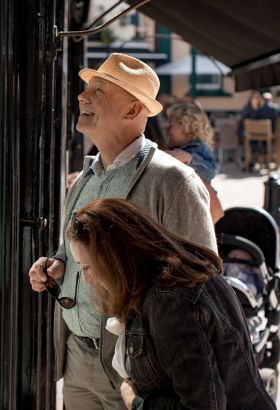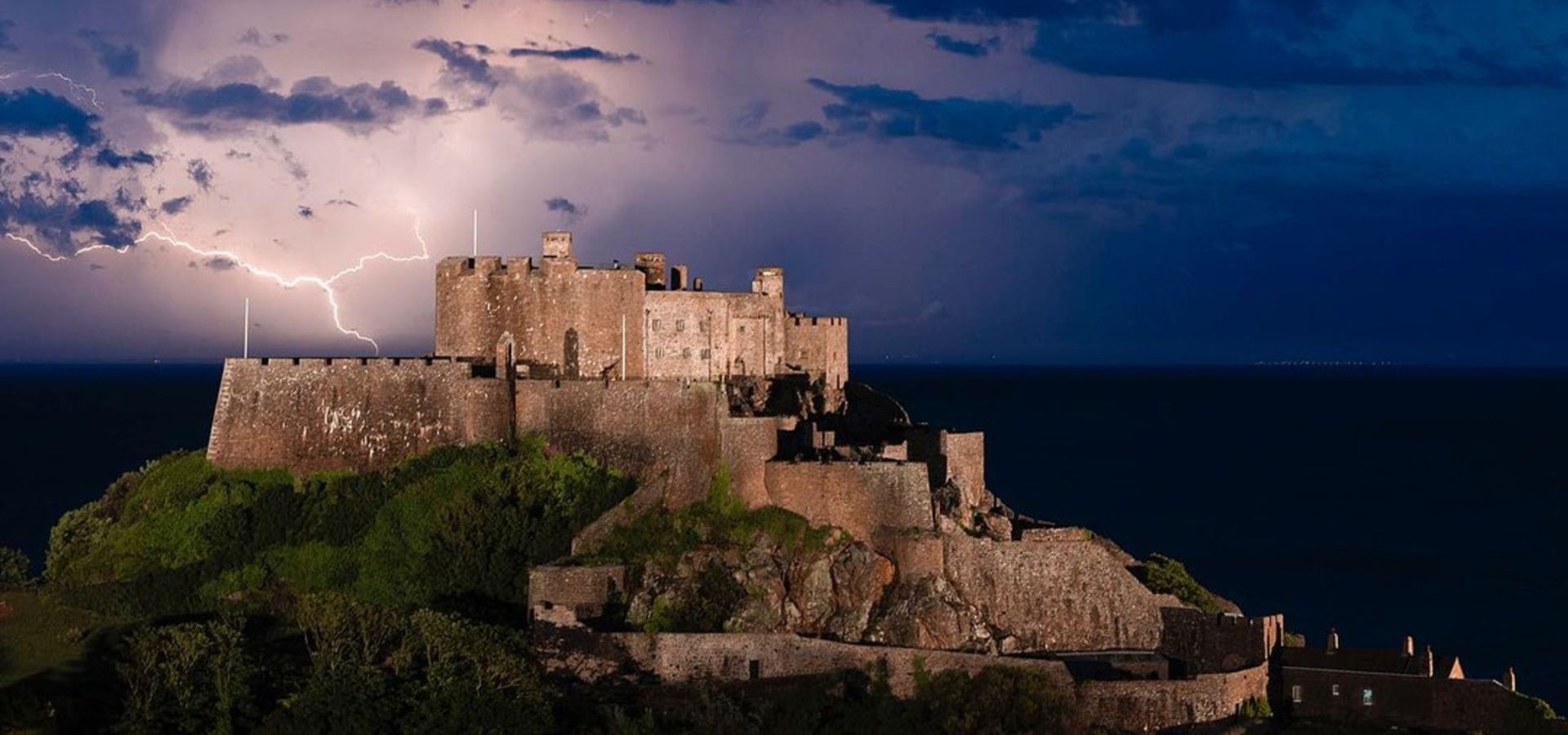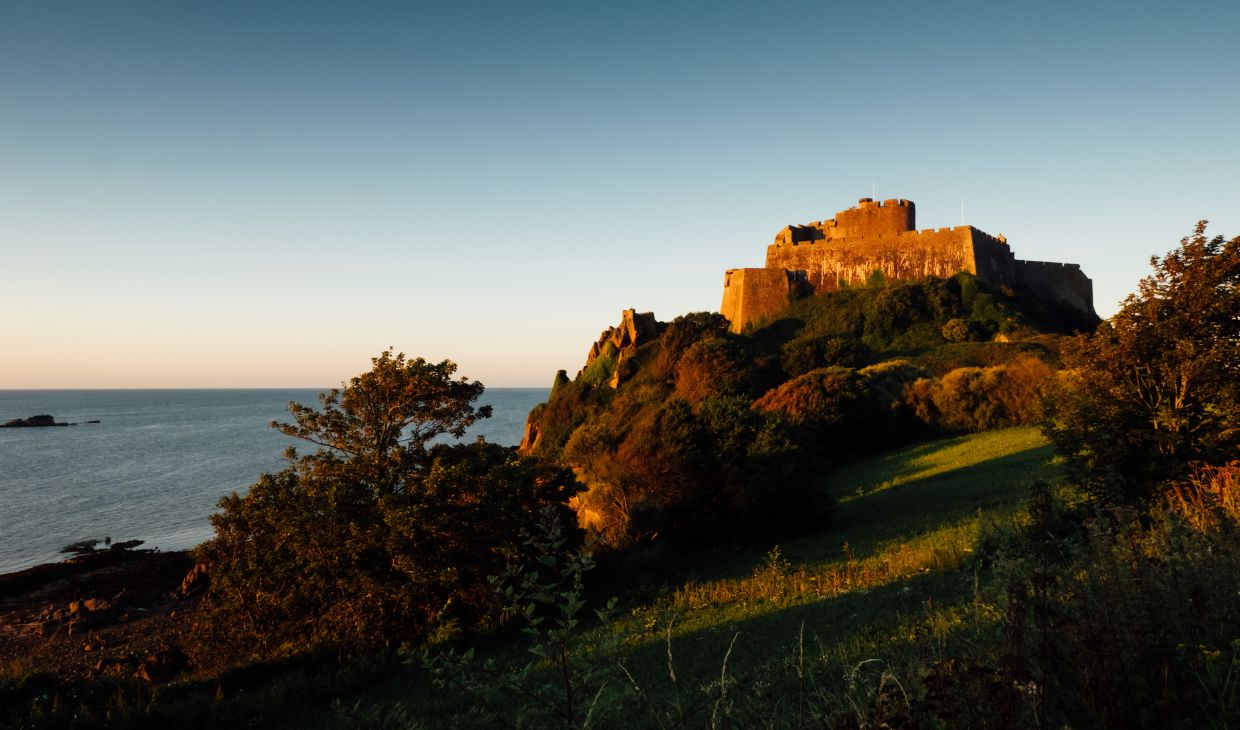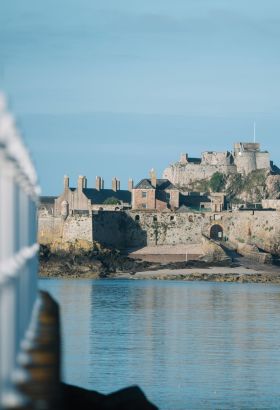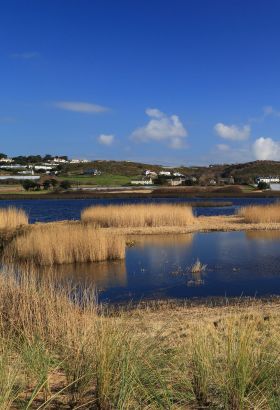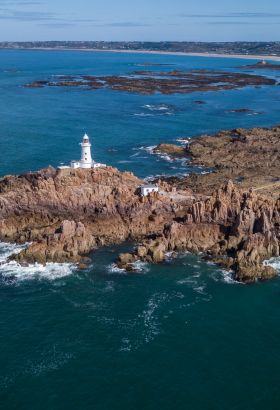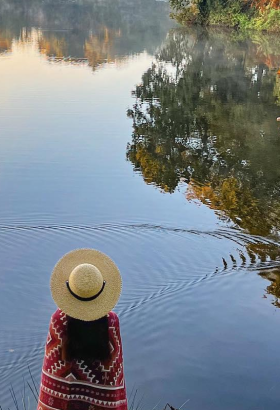Our island is a top spot for beautiful beaches, delicious grub and glorious sunshine. But, beneath the paradisical surface lies a spooky past. With 250,000 years worth of history within our nine by five miles, it’s no surprise Jersey holds centuries worth of spine-tingling tales that will leave you utterly spellbound.
Prepare to be enthralled as you delve into our island’s spooky treasure trove of myths and legends. Where dragons, witches, ghosts and faery folk lurk in the shadows, waiting for you to uncover their tales.
Are you ready to unearth the untold, embrace the magic and journey beyond reality?
Myth, legend and folklore
Step into a world of Jersey myths and legends, let the ordinary fade and the extraordinary take centre stage.

Myths and legends
The black dog of Bouley Bay
Perhaps the most famous of Jersey legends concerns a giant black dog which allegedly roams the steep hills surrounding Bouley Bay.
Smugglers who once used the bay to illicit cargo spoke of a dog with a vicious and evil nature. More ancient tales report that the canine was a storm herald; a sighting of the dog, or the sound of its howl, would warn fishermen to stay away from the sea.
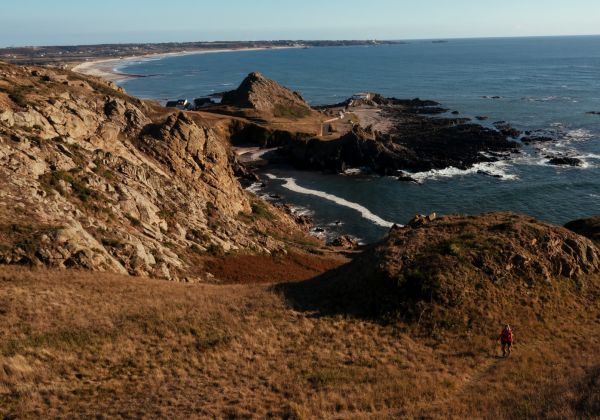
The manor under the sea.
Over 650 years ago a man owned The Manor of Le Brequette, a huge house at L’Etacq which was surrounded by a glorious oak tree forest. One year, as raging storms brewed, waves arose across the bay of St. Ouen and began to flood the land. The sea rose so high it consumed the manor and the surrounding oak forest.
Today, when the tide is low, you can still see the black tree stumps of the petrified forest that once surrounded the manor.

Jeffrey's leap.
Venture to the east of the island and you will find a huge rock which sits at Anne Port called Jeffrey’s leap.
Jeffrey had committed a crime and his punishment was to be thrown off the high rock. Locals came to watch Jeffrey get hurled off the rock and meet his end. But, by a stroke of luck, he survived without injury and swam to shore.
Full of bravery and certainty, Jeffrey boasted he would repeat the leap to show off how easy it was to survive. This time, he wasn’t so lucky as he leapt off, he hit his head on the rocks below and was killed.
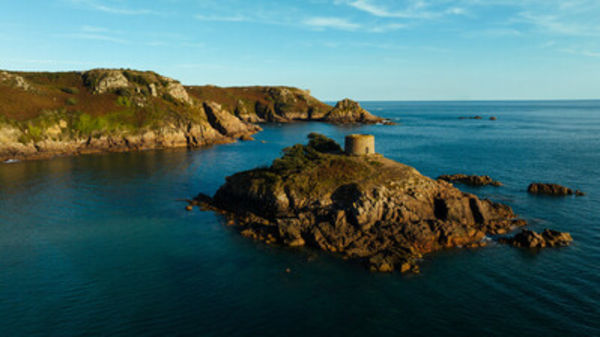
Janvrin's tomb
In 1721, a Jersey captain named Philippe Janvrin was sailing back from France when he was struck by the plague. No ships from France were allowed to dock in Jersey due to the disease, so Philippe had to quarantine off the coast.
On his second day in quarantine, he sadly passed away but his body could not be brought ashore. The enchanting island of Île au Guerdain, nested in the breathtaking bay of Portelet, became his initial resting ground before supposedly being reburied on land.
The legend of La Hougue Bie
Legend weaves a tale of a fearsome dragon that lived in St. Lawrence and terrorised people all over the island, leaving destruction in its fiery wake. The Seigneur de Hambye, a valiant knight from Normandy, caught wind of this menacing threat and set forth on a heroic quest to confront the beast.
The specifics of this battle remain shrouded in mystery, except the courageous knight engaged the dragon in a fierce one-on-one combat, ultimately triumphing by slaying the fearsome creature and severing its head.
Exhausted, Seigneur de Hambye decided to rest, entrusting his loyal squire to guard him. But, in a shocking twist of fate, the squire’s loyalty crumbled as envy took hold. He murdered his master, buried his body and returned to Hambye where he told the Seigneur’s wife the dragon had killed his master and he had avenged his death by killing the beast. He also added that the Seigneur’s dying wish was that the squire should marry his wife.
One night, as they lay in bed, the squire cried out in his sleep that he had killed his master. The lady immediately brought him to trial where the squire confessed. She then travelled to Jersey where a mound was raised in the parish of St. Saviour as a memory of the Seigneur de Hambye.
The five Spanish ships
In the autumn of 1495 as a fierce storm brewed off Jersey’s west coast, five Spanish ships traversed the English Channel, only to be ensnared by the treacherous tempest.
Unscrupulous islanders perched atop a cliff at St. Ouen’s Bay, anticipating shipwrecks and plunder. They deceptively lit fires, leading the Spanish ships to believe they were guiding them to safety. The vessels, deceived by the flames, neared the treacherous rocks while the wreckers reveled in their betrayal. Four ships foundered on the jagged rocks, but the largest remained afloat, carrying an elderly man and his daughter.
The man begged the wreckers to save his daughter, but they callously laughed. In a tragic twist, a colossal wave swept the girl to her demise. As the ship sank, the old man cursed the wreckers, vowing to meet them beneath the bay’s waters in one year’s time. True to his word, a year later, the wreckers gathered to celebrate surviving the curse, but nature’s fury intervened, submerging the land and drowning them beneath the sea’s depths.
Crack ankle lane
In the centre of the island, near the lush and dramatic beauty of St. Peter’s Valley, stretches a steep footpath. It was believed to be inhabited by a monster called the Vioge. Like an emaciated scarecrow in appearance, this demonic creature would grab it’s victims ankles, cracking them so they couldn’t run and dragging them to a hidden lair, where it has been consuming human flesh for centuries.
The bull of St. Clement
Jersey fisherfolk once talked of a roaring bull that roamed St. Clement’s beach at low tide. The locals were terrified and many refused to venture down, even to go fishing.
One fisherman did not believe such a tale and decided to brave the beach in search of the bull. Whilst out searching, he began to hear the bull’s roar. Instead of running away, he followed the sound, where he found a rock pool. The rocks had eroded to form a pipe and when the tide was low, the sea water was sucked out of the pipe causing a roaring sound which echoed off the rocks. The fishermen together filled in the pipe, and the bull of St. Clement was laid to rest.
Faery Folk
Amidst the enchanting shores of Jersey, where rolling waves caress rugged cliffs and ancient whispers linger in the salty air, a hidden world of faery folk comes to life.
Faery folk
St. Brelade's Church
Did you know the parish church of St. Brelade was originally supposed to be built in the area named Les Quennevais?
This spot was considered the fairies’ special place but, nevertheless, workmen dug the foundations, laid the stones and left their tools ready for the next day.
When they arrived for work the following day, their tools and stones had been moved a mile away on the beach. This happened to the workmen again and again until it was decided it might be best to build on the beach.

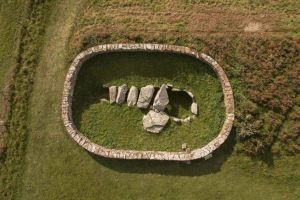
Faery folk
The Dolmens and Menhir stones
Our island is covered in many ancient dolmens and Menhir stones, which in Jersey folklore are said to mark the passages to the land of faeries.
Locals are told to beware the sight of goblins dancing around the stones, because if they catch you, they will make you dance yourself to death.
Le Lavoir des Dames
In the parish of St. John, hidden within the rocks at Sorel Point, you’ll find a rectangular pool named Le Lavoir des Dames. Legend has it that the faery folk would bathe in this pool and any man who caught sight of them would be struck blind immediately!
La Cocagne
A lesser-known legend in Jersey, but a spine-tingling one at that, is the legend of La Cocagne, a story parents would tell their children to warn them against staying out late into the night on their own. They would tell of an evil fairy or goblin that would hide under bridges and in wells waiting to lure children with magical concoctions, which if consumed, would curse them never to return to the mortal world.
William and the sea sprite
There was once a young woman, Anne-Marie, who liked to skim stones at Bonne Nuit Bay. A sea sprite had noticed her and wanted her for his wife. Determined to win her, the sea sprite plotted to eliminate her sweetheart – William.
The next day, William discovered a magnificent white stallion in the stable which he intended to show Anne-Marie. Later that night a dream warned him of danger, so he picked some mistletoe and took it with him riding. As he rode down the beach towards Anne-Marie, the stallion revealed its true form as the sea sprite and charged toward the sea to drown him. William fought back with the mistletoe, turning the horse into stone, now visible in Bonne Nuit Bay.
Witchcraft
Witchcraft was widespread in Jersey during the 1600-1700’s. In fact, the Channel Islands themselves have been described in many history books as being the witch-hunting capital of Europe.
Witchcraft
Jersey witch trials
In Jersey, at a time when the population was around 10,000 people, there were over 60 recorded witch trials that came before the Royal Court.
The accused were held at Mont Orgueil Castle until their trials, where many were convicted, banished and some let off with only a warning.

Witchcraft
Witches' stones
Witches’ stones are flat stones jutting from chimneys and are a fairly common sight on old Jersey houses.
According to Jersey folklore these small ledges were used by witches to rest on as they flew around. Householders would provide these platforms to appease witches and avoid their ill favour.
The witches of Rocqueberg
In the parish of St. Clement, you will find a rocky promontory known as Rocqueberq or ‘Witches rock.’ It is said that witches and devil worshippers would gather here and on one part of the rock you will find the devil’s hoof print.
Legend has it that witches would allow fishermen to pass safely along the coastline if they were thrown a thirteenth fish from their catch.
Another story tells us of a young man passing by who fell asleep next to the rock, only to awaken with beautiful girls dancing in a woodland area. He told his fiancé who warned him not to return, but he did. His fiancé consulted the priest who told her to follow him with a crucifix. She did just as he said, but when she arrived at the rock, there were no beautiful women only old hags who shrieked and vanished as she ran towards them with the crucifix.
Spellbinding Salem connections
In a surprising twist, one of Salem’s famous ‘witches,’ Philippe d’Anglois (or Philippe English), had a mysterious connection to our enchanting Island. Philippe of Huguenot heritage, was born in Jersey and embarked on a bewitching journey to Salem in the 1670’s.
Ghostly stories
From eerie echoes and haunting whispers within ancient castle walls to hair-raising ghostly encounters, Jersey’s after-dark spooks await those brave enough to explore.
House of screams
There is a tale of a house which stood on ‘ghost hill’ above the beautiful harbour of St. Aubin’s Bay.
The man who lived there would welcome French refugees to his house for food and a place to rest their head. But, in the dead of night, he would murder his victims in their sleep.
Years after the horrible incidents had stopped, locals could hear relentless screaming. The house was torn down and another built on top. However, shortly after, the screaming began again and the second house had to be demolished.
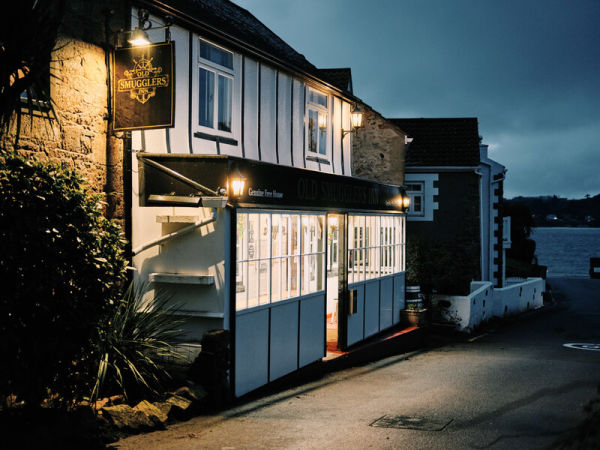
The woman in black
Step into the Old Smugglers Inn in Ouaisné Bay, where history meets mystery. Originally a 13th-century fisherman’s cottage, this charming spot has been both pirate hideout and modern inn. But, what sets it apart is the enigmatic woman in black. With a stern presence, she surprises guests and staff, wandering through the inn before vanishing.
Even after closing time, visitors have reported glimpses of her in a second-story window, only to watch her slowly retreat from view. Her identity remains a mystery, but, at the Old Smugglers Inn, she’s an integral part of the experience.
The ghost bride of Waterworks Valley
One of Jersey’s most famous ghost stories is the ghostly bride of Waterworks Valley. Long ago a bride waited at St. Lawrence’s Church to be married but her groom never arrived. She was so distraught by what had happened that she killed herself. Legend says that, once a year a ghostly horse and carriage with a bride inside rides down the valley in search of her disloyal husband.
Mont Orgueil Castle
There is a legend that the son of a castle guardian made a disadvantageous marriage. The guardian was so infuriated at his son’s disobedience that he murdered the boy and his young wife. It is rumoured that the shadows of the young couple can still be seen standing upon the spot where they were wed.
Lady and the lake
Another ghostly bride tale haunts our little island, this time a reluctant bride drowned herself on her wedding day to avoid an arranged marriage. She is said to haunt a lake in Jersey, enticing men to their deaths.
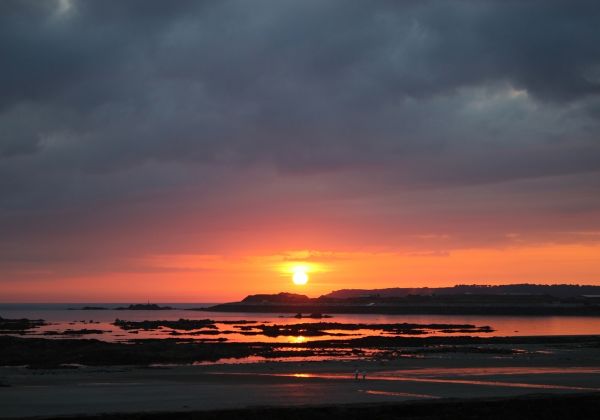
If we’ve peaked your curiosity with our ghoulish tales from island days gone by, then why not book your own hair raising holiday with the help of our trip planner and get ready to embark on a an adventure through our island’s legendary tales firsthand.


